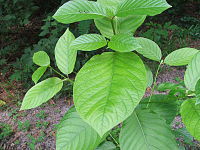
Photo from wikipedia
Ankylosing spondylitis (AS) is an autoimmune disease affecting parts of the skeletal structure in particular. Previously increased levels of the inflammatory cell types Th17, Th22, Tc17 and Tc22 cells have… Click to show full abstract
Ankylosing spondylitis (AS) is an autoimmune disease affecting parts of the skeletal structure in particular. Previously increased levels of the inflammatory cell types Th17, Th22, Tc17 and Tc22 cells have been shown to be associated with AS. Here, we analysed the levels of inflammatory T cell subsets, related cytokines and clinical characteristics of AS patients vs controls from northern Sweden. Peripheral blood mononuclear cells (PBMCs) obtained from 50 AS patients and 50 matched controls were short term stimulated with PMA/Ionomycin, stained and analysed by flow cytometry. Plasma levels of Interleukin (IL)‐17, IL‐22, IL‐10 as well as clinically relevant markers were determined. Compared to male controls, male AS patients showed 1.5‐ to 2‐fold increases of Th17 (P = .013), Th22 (P = .003) and Tc22 (P = .024) among CD45+CD3+ lymphocytes. Plasma IL‐22 levels correlated with the Tc17 proportion in male patients (Rs = 0.499, P = .003) and plasma IL‐10 levels were inversely correlated with Tc17 among all patients (Rs = −0.276, P = .05). Male patients with syndesmophytes showed significantly higher Th17 proportions (P = .038). In female AS patients, Tc22 was negatively correlated with C‐reactive protein (high sensitivity) (hsCRP) (Rs = −0.573, P = .016). We confirmed increased proportions of inflammatory T cells and correlations with relevant cytokines from male AS patients. The correlation between Th17 and syndesmophytes supports a role of Th17 in the pathogenic process.
Journal Title: Scandinavian Journal of Immunology
Year Published: 2022
Link to full text (if available)
Share on Social Media: Sign Up to like & get
recommendations!